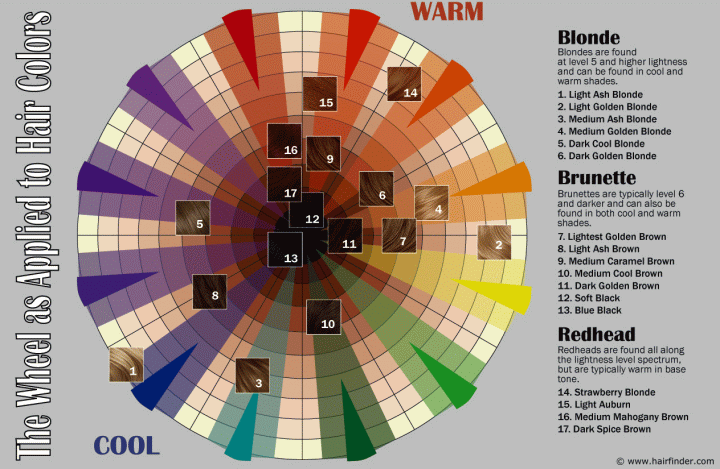How to Use the Hair Color Wheel (2)

Previous page
Coolness and Warmth
One of the primary ways in which we divide hair colors is into cool shades and warm shades. Cool shades are those that have base colors which are cool: blues, violets, greens (also referred to as drab) and are often named with indicative terms like "cool", "icy", "platinum", or "ash".
Warm shades are those whose base colors are from the warm colors: red, orange, and yellow, and they typically bear names that evoke warmth or reflect their color in other terms: "cinnamon", "auburn", "burnished", "sunlit", "copper", "golden" and sometimes simply "warm".
Blondes, Brunettes and Redheads
We all would say we can spot a blonde, but there is a specific designation of the crossover point from blonde to brunette. Colors that are level five and above (up to level ten) are classified as blondes (unless they are in the red family). Thus, blondes can be cool, such as platinum blondes and ash blondes, or they can be warm, such as with golden blondes
Brunettes usually start as we darken to level six and darker - all the way to black. The base tones of these shades can be warm (such as caramel tones or honeyed browns) or cool (as with ash brown and blue-black).
Redheads generally are found in the warm spectrum of the color wheel, but can be virtually any level of lightness - every shade from strawberry blonde, down to dark spiced brown. Redheads can be bold and brassy copper-tops like Lucille Ball, or Carol Burnett, or more sedate celebrity redheads like country music singer Naomi Judd, and her actress-daughter Ashley Judd who has dark auburn hair.

Seeing how the colors lay out along the wheel helps to show you their relationships and gives advice on how to deal with problems that may arise – as well as preventing those issues from occurring in the first place. When choosing a color, it can be best to stick with analogous color bases to your starting shade.
If you want to go in a different direction with the color of your hair – say if you are a redhead and want to tone down the hue of your red mane, then you could perhaps use the color wheel to find a color on the opposite side of the spectrum and apply it to tone down the color.
In the case of a redhead such as dark spice brown, you could use a medium ssh blonde, or even a medium cool brown to neutralize some of the red tones. Just be aware that applying a dark shade of color on top of a dark shade of color will only result in increased darkness of the color, regardless of the base color.
Final Notes: Neutrals
There is one group of color bases that we don't discuss here, since they don't actually have a "color". I am referring to "neutral" based hair colors. These hair colors are designed to be used with hair on which you don't know the base color, in an effort to avoid unfortunate color reactions in your hair coloring process.
Neutral shades would fall along the lightness level charting without being influenced by the base colors themselves. Generally speaking, these are the "safety net" colors; the ones that can be used with more confidence and without fear of bad color outcomes.
Lightening a red-based color with a neutral blonde formula would result in a red-based finished color, but only because the red pigments were there from the beginning. Neutrals are also great for darkening the hair color without worry of pigment overload from duplicating the base color in the hair color formula.
©Hairfinder.com
See also: The difference between cool and warm hair colors